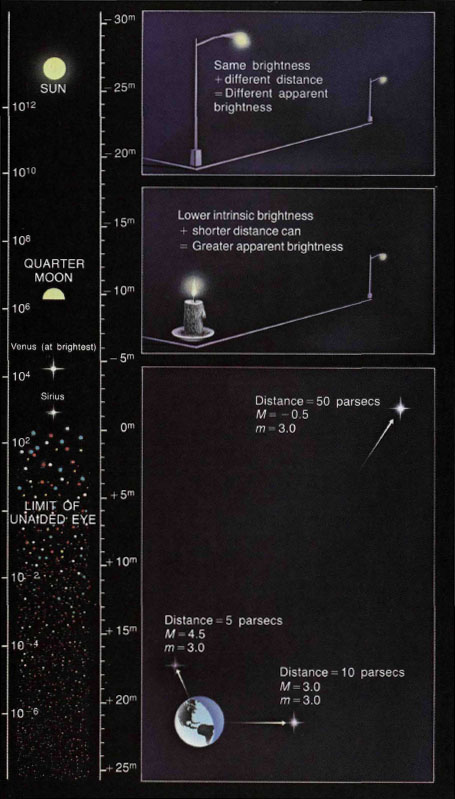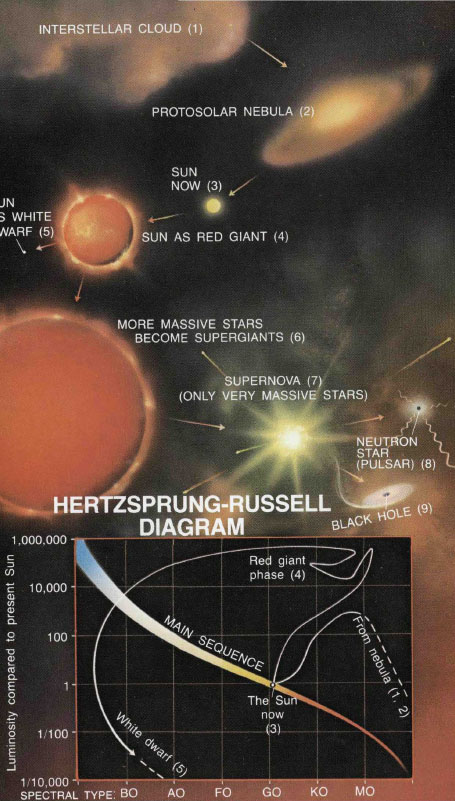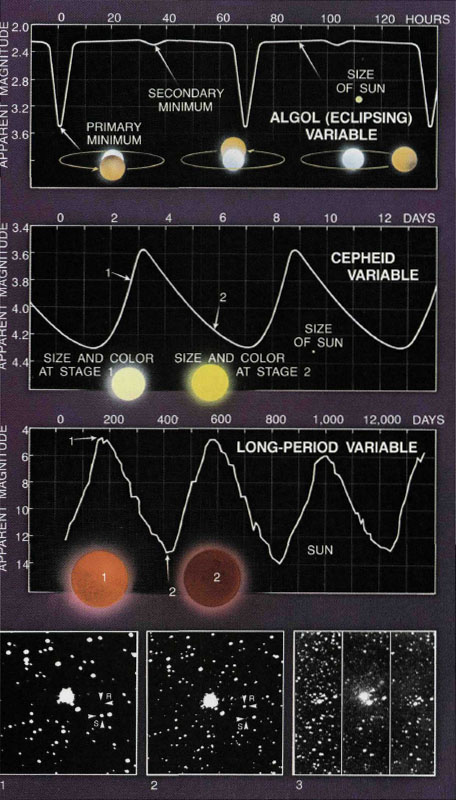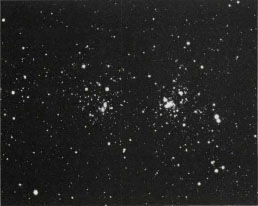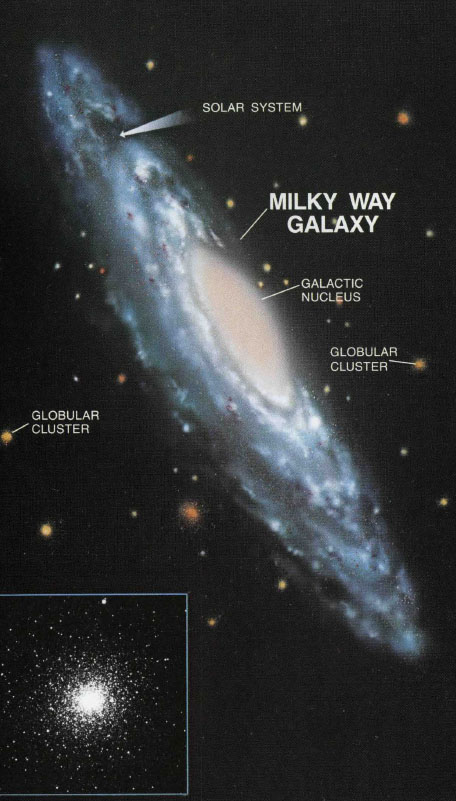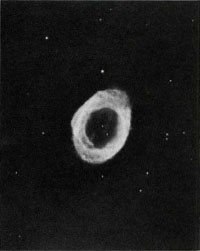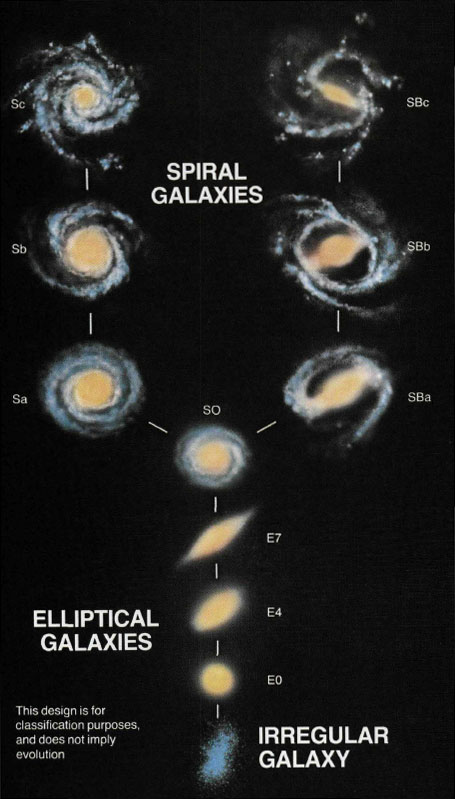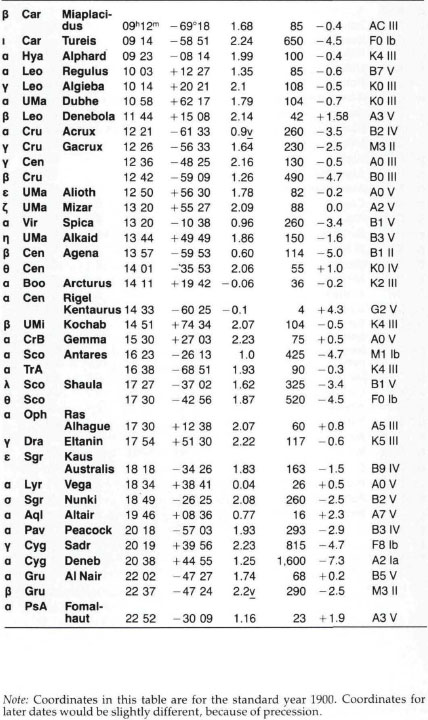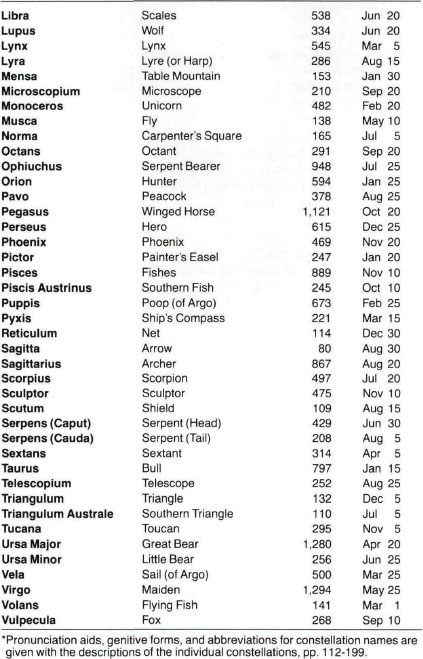THE MAGNITUDE SCALE
Celestial objects appear in a vast range of brightnesses. The midday Sun is 16 trillion times brighter than the faintest stars just visible to the dark-adapted eye. The faintest stars photographable with our largest telescopes appear only a hundred-billion-billionth as bright to us as our Sun. Such numbers are hardly understandable and some other means of expressing astronomical brightnesses was needed. Hence the magnitude scale: a logarithmic scale in which a difference of exactly five magnitudes corresponds to a factor in intensity of 100 times. Thus one magnitude, written 1m, corresponds to a factor of the fifth root of 100, or 2.512, so that:
1m = a factor of 2.512, or about 2½
2m = a factor of 6.310, or about 6¼
3m = a factor of 15.840, or about 16
4m = a factor of 39.811, or about 40
5m = a factor of 100, exactly.
For example: Suppose two stars differ in magnitude by 13m. To find the difference in brightness in arithmetic terms, first break 13m down into as many 5m intervals as possible; thus, 13m = 5m + 5m + 3m. Replace each 5m by the number 100 and each + by ×. From the table above, you can find that 3m corresponds to another factor of 16. Thus, 13m = 100 × 100 × 16 = 160,000 (times as bright). For the greatest possible exactness, magnitudes may be given to one or more decimal places; e.g. 1.80 for the star Algenib.
The magnitude scale is set up in such a way that light from the brightest objects is measured in terms of negative magnitudes. The brightest star, Sirius, is – 1.4m; Venus can be as bright as – 4m; the Sun is –27m. The faintest stars seen by the unaided eye are about 6m.
This scale is for apparent magnitude: it measures how bright things appear to us. Denoted by m, it depends on two conditions: how bright the source really is, and how far away it is. The intensity of light from a point source falls off inversely as the square of the distance from it. Thus at 100 feet a streetlight will look 16 times brighter than one of the same kind at 400 feet. In the bottom illustration, all three stars could have the same apparent magnitude as seen from Earth, yet differ in intrinsic brightness and in distance from us.
Intrinsic brightness is measured by absolute magnitude, denoted by M, and defined as the magnitude a celestial object would appear to have at a distance of exactly 10 parsecs (about 32 light-years). For any object at distance r from us (measured in parsecs), the relation between apparent and absolute magnitudes is:
m – M = 5 log10r – 5
STAR COLORS AND SPECTRAL TYPE
You may notice that the brighter stars are slightly colored. Every star is of some color, but the fainter the star, the less sensitive the eye is to its color. Color descriptions of stars, moreover, are only approximate.
With the invention of the spectroscope 150 years ago, it became possible to divide the light of any star into its component colors, forming a stellar spectrum. Most spectra have a full range of colors, from blue to red, with a few particular colors, or ranges of color, missing. The missing ones, usually designated by the wavelengths of the light, show up as dark lines or bands in the spectrum.
The overall color of a star is an indication of its temperature, just as the dull-red glow of a rod of metal in a fire indicates relatively low temperature; brighter red, a hotter temperature; and orange, yellow, and white, progressively hotter temperatures still. Dark lines result from selective absorption of light by various chemical elements in the star’s atmosphere. The lines differ in stars of different temperatures because the different elements absorb light at different temperatures.
Stellar spectral types, in order of decreasing stellar surface temperature, are designated as O, B, A, F, G, K, and M. Note that only surface temperature is directly observable. The standard mnemonic for spectral types is “Oh, Be A Fine Girl, Kiss Me.” Finer divisions are distinguished by dividing each class into ten parts, or sometimes even smaller divisions. Thus a star may have a spectral type of A5 (cooler than A4, hotter than A6) or G2 or B1.5.
Stars are believed to evolve, as described here. Over the course of time, this evolution affects their spectrum. Stars of types O, B, and A are said to be early-type stars, while those of types K and M are said to be late-type. A B3 star is said to be “earlier” than a B9. If there are peculiarities in the spectrum, a “p” is placed after the type. (A very few stars are of types denoted by WN, WC, R, N, S. White dwarfs may have a designation such as DA. For more information, consult an astronomy text.)
The luminosity class of a star, corresponding to its absolute magnitude, is designated under two schemes:
| New Notation | Old Notation | Luminosity Class |
| Ia, Iab, Ib | c | Supergiants |
| II | Bright giants | |
| III | g | Giants |
| IV | sg | Sub-giants |
| V | d | Dwarf (main sequence) |
| VI | wd | White dwarf |
A complete spectral designation for the star Vega might be given as A0V (read “A-zero-five”) or as dA0 (read “dwarf A-zero”).
STELLAR EVOLUTION
Stars form from vast interstellar clouds of gas and dust. As a cloud contracts under its own gravitational pull, it heats up (1) and its atoms move faster. Finally the central part of the cloud detaches from the rest, concentrating to form a protostar (2). Parts left behind may form other stars or a planetary system. As the protostar gets denser and hotter, the central region reaches several million degrees, and nuclear fusion occurs—hydrogen atoms combine to form helium, with a release of energy. The now-mature star blows away the remaining gases and settles down to a career on the main sequence (3), lasting most of its lifetime. How long that lifetime will last, how long the star took to reach that stage (in all cases a small fraction of the main-sequence lifetime), and what size, spectral type, and color the star will become depend on the mass of the star. The more massive stars are hotter, larger, and brighter than stars with less mass. They also have shorter lives—a few million years for the hottest O-type stars, about 10 billion years for stars like the Sun, and perhaps tens of trillions for cool, red stars.
Gradually a star runs out of hydrogen fuel at its core, cools, and swells to become a red giant (4). At this stage, stars of spectral type about F5 and cooler simply begin to cool off and shrink, eventually becoming about the size of Earth. Such are the white dwarfs (5), which, consisting largely of atomic nuclei stripped of their electron shells, are incredibly concentrated, typically having masses which on Earth would weigh perhaps 5 tons per cubic inch. Eventually white dwarfs cool to dark cinders.
More massive stars may go through several red giant stages, even evolving into supergiants (6) thousands of times larger than the Sun. During these portions of their lives, they will form chemical elements as heavy as iron in their cores. Most stars become variable in light output in their later stages, and the most massive ones may explode cataclysmically as supernovae (7), leaving behind perhaps a neutron star (8) which may be a pulsar, or even a black hole (9)—a region around a “dead” star so dense and gravitationally attractive that the light cannot escape from it. In the explosion, chemical elements heavier than iron are formed and spewed out into the interstellar material, to be incorporated later in new generations of stars.
Astronomers use the Hertzsprung-Russell diagram to describe the life story of a star (and for many other purposes). The diagram is a graph of spectral type (color, or temperature) versus brightness (luminosity). Each point on the graph represents the surface properties of a star, and a line on the graph is the sequence of stages a star goes through as it evolves. The main sequence is the location on the graph of those stars that are in the main hydrogen-fusing stage of their lives.
MULTIPLE STARS
Our Sun has planets orbiting it. Some stars are orbited by other stars—sometimes several. These are called multiple stars and include binary systems, triple systems, and so on. More than two thirds of all stars have stellar companions.
An optical double is a pair of stars that appear close together along our line of sight but are actually very far apart in space. They have no physical connection, gravitational or otherwise.
A physical double is a pair of stars gravitationally bound to one another as a system. The same is true of physical triplets, quadruplets, etc. In a system of only two stars, the true orbit of one body about the other lies in a plane, and the shape of the orbit is an ellipse (see Kepler’s laws, here). As seen from Earth, the plane of the orbit may be oriented so as to make the orbit appear different from what it really is. The upper illustration shows the true orbit of such a system, and how it would appear from Earth as one star moves about the other. Such a system may even appear edge-on, so that one star periodically eclipses the other (here).
Both members of a physical double revolve about their common center of mass. This obviously is not a visible point. It is thus usual to refer to the less-bright star, called the secondary, as orbiting the brighter one, called the primary.
Study of a binary, or double star, includes repeated observations, over a span of years, of two measurements: the angular separation of the two stars and the direction in the sky of the secondary from the primary. Angular separation is expressed in seconds of arc. Direction, referred to as position angle (PA.), is measured in degrees starting from the north direction (0°) toward the north celestial pole, through east at 90° and around through south, west, and back to north. (P.A. is somewhat analogous to azimuth.) In the eyepiece view shown, the P.A. of the star system is about 250°. Accurately aligned crosshairs in the telescope eyepiece are necessary for such observations. Often another pair of adjustable crosshairs is used to measure the separation. A series of observations of separation and position angle can be plotted to obtain the apparent orbit. Then, from a knowledge of the laws of orbits, the true orbit can be calculated.
A double star’s period (the time required for completion of the orbit) may be of almost any length, from days to centuries. Only those stars with relatively wide separations can be seen as separate stars. Very close binaries are not detectable by visual inspection, but their double nature can be deduced from their spectrum. The relative motions of the stars cause shifts in the lines of the spectrum, and from these shifts it may be possible to calculate the orbit. These close double star systems are called spectroscopic binaries.
Multiple star systems make it possible for astronomers to compare the evolutionary processes of stars with a common origin. Eclipsing binaries (here) which are also spectroscopic binaries are extremely valuable in giving astronomers knowledge of the relationship between spectral types and stellar sizes and masses. These fundamental data, obtainable in no other way, are used to validate and refine our theories.
When there are more than two stars in a physical system, the orbits are much more complicated, do not necessarily lie in a single plane, and cannot be represented mathematically by any simple equation. Astronomers wishing to predict the motion in such a cosmic ballet must calculate the motion step by step. Often, however, such a system will consist of a close pair of stars orbited by a more distant star, or even by another close pair. A good approximation of the motions of each pair can be calculated, assuming each is a simple binary, by considering each as a single star.
The nearest star system, Alpha Centauri, is a triple: a G2-type star and a K5 orbit each other closely with a period of 79.9 years, and a third—a red dwarf—orbits the pair. At present this red star is believed to be in a part of its orbit that lies on the side of the pair nearer Earth and thus is the closest star to the solar system; hence its name, Proxima (from Latin proximus, “nearest”).
A favorite object for small telescopes is Theta Orionis, a quadruple star often called “The Trapezium” because of the arrangement of the components, buried in the haze of Orion’s Great Nebula. The four sparkling, very blue stars can be distinguished in binoculars.
In the accompanying list of multiple stars, R.A. is the right ascension; Dec, declination; m1 apparent magnitude of the primary, and m2, of the secondary (v if variable); P.A., position angle in degrees; and Sep., separation in seconds of arc. A is the primary; B, the secondary; C, the tertiary.
MULTIPLE STARS FOR BINOCULARS AND SMALL TELESCOPES
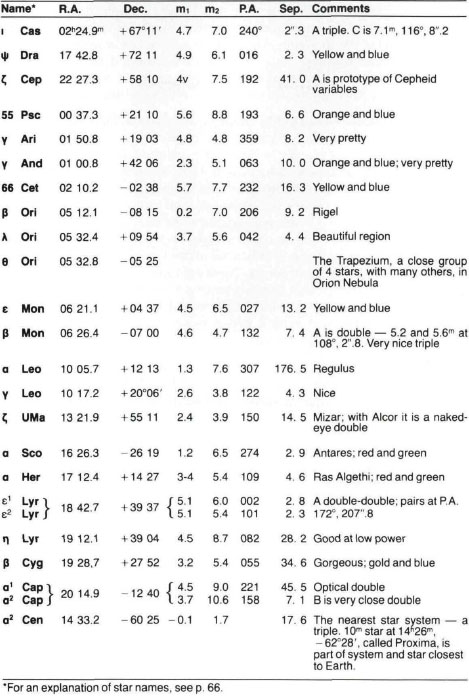
VARIABLE STARS
The light produced by some stars varies in intensity. Repeated observations of the changing magnitude of a variable star over time yield a graph called a light curve. Variables are classified according to the differences in their light curves. Some variables vary over regular periods, others are semiregular, while others are completely irregular.
EXTRINSIC VARIABLES: These are stars whose light output is constant, but periodically is partially or completely blocked from our view by another star passing in front. They are also termed eclipsing variables, or Algol-type variables (from Algol, the first such object discovered). Actually, an eclipsing variable is a pair of stars oriented so that Earth lies in or very near the plane of their mutual orbit. Twice during each orbital period there is an eclipse. If the stars differ in spectral type, the eclipse in which the cooler star passes in front of the hotter one is called the primary eclipse. When the hotter star passes before the cooler one, a secondary eclipse occurs. These points on the light curve are called primary minimum and secondary minimum, respectively. We cannot observe the two stars separately: their doubleness is deduced from the light variations. A typical period is several days, and the minima usually last minutes to hours.
INTRINSIC VARIABLES: These are stars whose light output changes because of the star’s own internal and surface changes. There are many types of such variables, each usually named for the first star of its type identified—the “prototype” star. Opposite, in photo 1, is the variable S Scorpii in a bright phase; in photo 2, taken later, S Scorpii is fainter, but near it is another variable, R Scorpii, now bright enough to see.
Cepheids are among the most numerous and well-known types. These are supergiants that pulsate, changing in surface temperature—hence also in spectral type—over a period ranging from a few days to a few months. A numerical relationship has been observed between the period of pulsation and the average magnitude. Thus, by measuring the period of a Cepheid the astronomer can learn its absolute magnitude. By comparing this with its apparent magnitude he can calculate its distance from Earth. Distances of remote star clusters and galaxies that contain Cepheids can also be measured in this way.
Long-period variables, also called Mira-type variables, are red supergiants with periods of hundreds of days and a great range in magnitude variation. Mira, the prototype, varies in magnitude from 3 to 10 over a period of 322 days.
Novae are stars that explode partially, brightening as they throw off a small percentage of their mass. Then they fade. Supernovae are stars that explode cataclysmically, almost totally disintegrating in this final evolutionary stage. Opposite (3) three photos, taken at different times, show brightening and dimming of the Nova of 1910 in Lacerta.
OPEN STAR CLUSTERS
Some stars occur in clusters. Presumably formed from the same cloud of interstellar material at about the same time, they share a common age and composition and are more or less gravitationally bound. The two types are globular clusters (here) and open, or galactic, clusters.
Open clusters are relatively open, irregular groups, consisting of a few dozen to several thousand stars. Even though they appear close together in photographs, the average spacing is several light-years. These are second-generation stars or even younger, formed some time after the original galaxy. Because they were formed in part from debris of older, exploded stars, in which heavy elements had formed, they are relatively rich in heavy elements, in addition to hydrogen and helium. The fact that these stars have similar ages and compositions helps astrophysicists understand how stars’ properties change with spectral type, other variable factors being constant.
Still looser groupings of very young stars are called associations. Only a few millions of years old, these groups are dispersing. If close to us, they are so spread across the sky that their grouping is not obvious.
At the top here is an illustration of what our Milky Way might look like from outside: a flat disk, called the plane of the galaxy, a central bulge called the nucleus, and the region surrounding all of this called the halo. The spiral arms, so hard to detect from our interior vantage point, lie in the plane, and here, too, are found the open clusters. Most of the stars in the plane of the galaxy were formed more recently than those in the nucleus and the halo.
Open clusters include some of the most interesting and beautiful objects in the sky. Several, such as the Pleiades, Hyades, and Double Cluster in Perseus, are visible to the unaided eye. In binoculars or a small telescope they are dazzling. Sometimes they are associated with gaseous nebulae, such as the Great Nebula in Orion.
OPEN CLUSTERS FOR BINOCULARS AND UNAIDED EYES
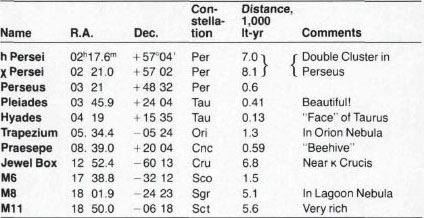
The “Double Cluster” in Perseus, h and X Persei
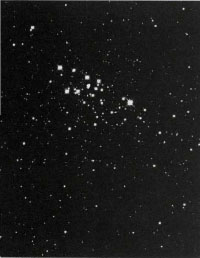
A sparse open cluster, NGC 7510
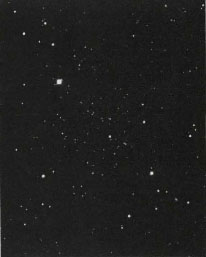
A very loose cluster, Abell 5
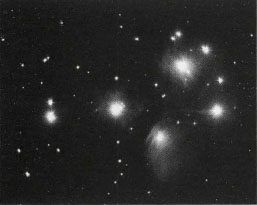
The Pleiades cluster, showing nebulosity
GLOBULAR STAR CLUSTERS
Globular clusters are immense spheroidal, relatively compact groupings of hundreds of thousands or millions of stars. Formed early in the evolution of the Milky Way galaxy, they surround it in a region called the galactic halo, centered over the galactic bulge. Most globulars are very distant from Earth. A few are visible as small fuzzy patches to the unaided eye under good conditions; many are visible in small telescopes. The fainter and more distant ones appear only as slightly fuzzy starlike objects.
Globular clusters contain stars that were the first to form when the galaxy was condensing from vast clouds of intergalactic material. This primordial gas contained very little in the way of elements heavier than hydrogen and helium. Most of the gas was used up in making the stars; hence, globulars contain little interstellar material. Because they are isolated from the rest of the galaxy, they were never enriched with more interstellar material, so no second-generation stars formed in globulars as they did in the plane of the galaxy.
In a telescope, globular clusters appear much as they do in photographs, except that a photograph tends to overexpose and blend together the stars near the center. The cluster shown is M13, in the constellation Hercules—a fine cluster for a small telescope.
The table below lists some of the more famous globular clusters.
GLOBULAR CLUSTERS FOR BINOCULARS AND SMALL TELESCOPES
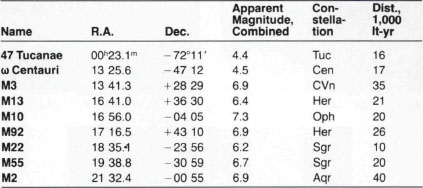
GALACTIC NEBULAE
Gas and dust pervade the disk of our Milky Way galaxy. Concentrations into dense clouds are called nebulae. Some are dark, hiding the light of stars behind them; others are luminous, like cosmic neon signs.
Dark nebulae are visible most often as silhouettes against a brighter background. Most of the mottling and seemingly vacant regions in the band of the Milky Way are caused not by a paucity of stars but by absorption of the starlight. Even where the interstellar material is not concentrated into noticeable clouds, it tends to dim and redden the light of more distant stars.
Emission regions, or emission nebulae, are gas clouds—mostly hydrogen like the rest of the universe, mixed with small amounts of helium, oxygen, nitrogen, and other elements. These elements are excited into luminescence by ultraviolet radiation from nearby stars that are hotter than about spectral type B1. The gases absorb the invisible ultraviolet radiation, and reradiate it in the visible part of the spectrum. Such nebulae may contain stars in the process of forming from the gas, or stars just formed. The best-known such nebula is the Orion Nebula, visible to the unaided eye in the “sword” of that constellation.
Reflection nebulae are clouds of interstellar material in which the dust component—of unknown composition—reflects the light from nearby stars. These stars are usually too cool to excite the gases in the nebula to glow, although some nebulae show both emission and reflection properties. The most famous example of a reflection nebula is that surrounding the Pleiades star cluster; the nebulosity is not visible to the unaided eye, but appears when long time-exposure photographs are taken.
Planetary nebulae are so named not because they relate to planets but because they are roughly spherical and some appear greenish, like the outer planets. A planetary nebula is a globe or shell of glowing gases thrown off by a star in a relatively mild explosion late in its evolutionary career. Sometimes the central star that excites the gas to glow can be seen. Because we are looking through a transparent spherical shell of glowing gas, the edges appear brighter than the central regions, and so the nebulae often appear as rings of light. The Ring Nebula in Lyra is the most famous.
Supernova remnants are the chaotic blast debris from very massive stars that have exploded and virtually destroyed themselves. Large optical and radio telescopes have in some cases detected the “corpse” of the star as a neutron star or pulsar at the center of the debris. The Crab Nebula, the result of a supernova recorded in China in A.D. 1054, is the most famous.
The “Ring” Nebula in Lyra, a planetary nebula. This shell of gas was ejected by the central star
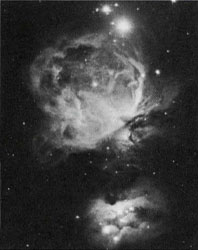
The Great Nebula in Orion, a luminous nebula containing young stars. Note several dark, absorbing regions
SOME GALACTIC NEBULAE
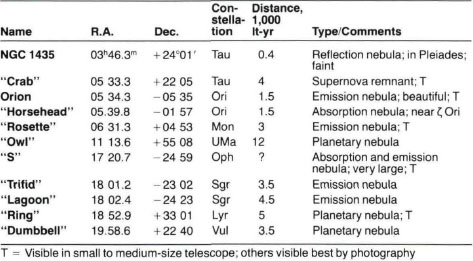
GALAXIES
Galaxies, the largest assemblages in the universe, range from dwarf elliptical galaxies, comparable in size to the largest globular clusters, to the sweeping spirals and the supergiant ellipticals containing thousands of billions of stars.
Spiral galaxies are flat, disk-shaped forms with a central bulge. They are denoted by the type letter S, with letters a, b, and c denoting increasing openness of the arms. S0 galaxies are flat, but show no spiral arms. The Milky Way galaxy (illustration, here; see here) and the Andromeda galaxy are examples of type Sb.
Barred spirals also are flat systems, but with spiral arms trailing from a barlike feature which extends through the galaxy’s center. They are denoted as type SB, again with letters a, b, and c denoting increasing spread between the arms.
Ellipsoidal galaxies range from spherical to football-shaped forms. Whereas spirals contain much interstellar gas and dust, with both young and old stars, ellipsoidal galaxies (sometimes called ellipticals) are composed only of old stars, with little or no interstellar material. They are designated type E, with numbers running from 0 to 7 to indicate the progression from spherical to spindle-shape. Dwarf ellipticals are the smallest of all galaxies; supergiant ellipticals are the largest.
Irregular galaxies, with no particular shape, designated / or Irr, contain mostly young stars, with much gas and dust. The Magellanic Clouds, companions of our Milky Way, are examples.
Peculiar galaxies, denoted by the letter p after some other designation, are galaxies that depart from the norms. They may show features of several galaxy types, may be strong sources of radio waves, or may have other peculiarities.
The representative galaxies listed below are visible in small and medium-sized telescopes, but don’t expect them to look like the long time exposures made with large telescopes. All are far more distant than the stars of the constellations in which we see them.
GALAXIES FOR BINOCULARS AND SMALL TELESCOPES
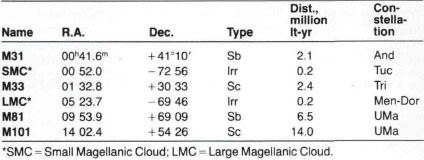
THE BRIGHTEST STARS
In the following table of the apparently brightest stars, the Bayer designation (from Johann Bayer, 1572-1625, German astronomer) and the common name (if there is one) are followed by coordinates for the year 1900. The apparent magnitude given is what astronomers call “V”: a “visual” magnitude based on measurements of the light received by standard equipment. If magnitude is given only to one decimal place, or if a small v follows it, the star is variable or otherwise unusual.
The distance to each star is given in light-years (lt-yr). Note that most of the apparently bright stars are both intrinsically bright and rather far away—more than 100 light-years distant. Only a handful are relatively close to us, and most of these are not intrinsically very bright. A table of nearest stars would include very few of the stars listed here.
Absolute magnitude indicates the actual luminosity of the star (here). The spectral type is listed according to classifications previously explained (here). If a star is double (as are two thirds of all stars), with components of nearly equal brightness, each of the pair contributes to the spectrum. Sometimes, too, a single star will show spectral features of more than one type. In both cases, the listing will indicate the composite spectrum—for example, “G + F” for Capella.
In the very brightest stars—those of magnitude brighter than about 1.00—the eye can detect colors, usually rather delicate, when seeing is good. O- and B-type stars will appear bluish white. A-stars will be white, slowly shading to yellow as the spectral type becomes F, then G. Type-K stars will be orange, and M-stars reddish. Among the more noticeable colored stars are Antares, red; Capella, yellow; Sirius, white; and Rigel, blue-white.
Most bright stars have proper names, such as Algol and Betelgeuse. For greater precision, astronomers designate stars by means of Greek letters or Arabic numbers with the name or abbreviation of the constellation in which the star is seen (here). Thus, α Andromedae (or α And) is the star alpha in the constellation Andromeda (“Andromedae” being Latin for “of Andromeda”). Ordinarily, but not always, the Greek letters are used in order of brightness, so that α And is the brightest star in Andromeda, β And the next-brightest, and so on. Other designations refer to their listings in various star catalogs.

THE CONSTELLATIONS
All peoples, from the ancient Sumerians to the medieval Arabs and the American Indians, have had their own sky lore. Celestial objects have been named after gods, people, animals, and tools, and groups of stars have been “connected” to form constellations. The shapes of some constellations suggest the names given to them, such as Draco the Dragon and Orion the Hunter; others, such as Ursa Major, the Great Bear, require a real effort to see any similarity at all. However, the established forms and names of constellations have been convenient, and many that originated in remote antiquity continue in use today.
A number of constellations, as defined on modern astronomical maps, contain some of the same stars that were assigned to them millennia ago. Familiar figures such as Cassiopeia and Orion can be identified on Sumerian tablets, Egyptian pyramids, or Greek statuary thousands of years old. Because stars are so far away and changes in their positions as the eye sees them are likely to become noticeable only over many centuries, the constellations of today have much the same shapes as when they were named by ancient man.
Many star names, such as Betelgeuse and Algol, are Arabic. In the so-called Dark Ages the Arabs, interested in astronomy, gathered up existing astronomical knowledge and added their own.
As the Dark Ages closed, astronomy became an important part of science in the Western world. Observers gave new names to some celestial objects and also named some parts of the sky that had not been previously identified. The new names represented all sorts of things—national leaders, heroes, dogs, optical instruments, and whatnot. Because communication between scientists in those days was poor, there was much confusion as to specific names and as to where one constellation ended and another began. Then, in 1930, the International Astronomical Union defined a set of 88 constellations with precise boundaries. Some of the old names and old constellations—for example, Aeronavigus Pneumatica (The Hot-air Balloon)—were eliminated. One long-recognized constellation, Argo Navis (The Ship), which sprawled over the sky widely, was divided into separate new constellations. Under the new scheme, the whole sky is covered.
Following is a table of constellations now recognized as official by astronomers throughout the world, with the constellation name, the object it is supposed to represent, its area in square degrees (the entire sky encompasses 41,253 square degrees), and the date on which the constellation is on the meridian at 9 p.m.

